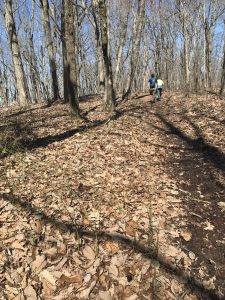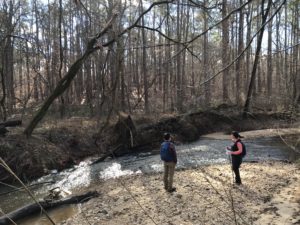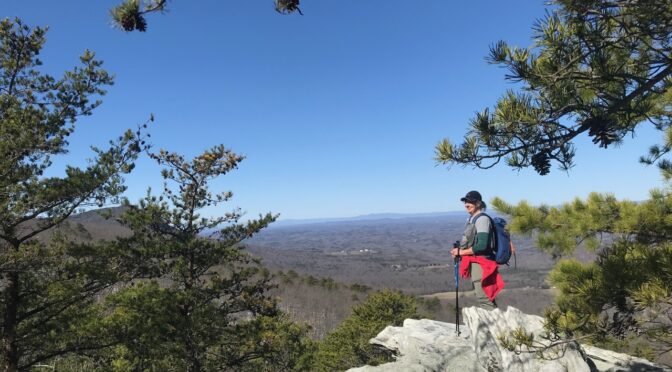In the early 1980s I lived in Loveland, Colo. On weekends, I would drive up U.S. 34 along the Big Thompson River toward Estes Park, into the Arapaho & Roosevelt National Forest. I would typically stop well short of Estes, sometimes not even making it to the tiny crossroads of Drake. I’d find a roadside pullout, get out and start hiking: there didn’t need to be a trail, as long as the terrain was passible. It wouldn’t be long, scrambling up the steep canyon walls, before I’d start fantasizing that I might be the first person to have ever made it to the ridge above. Hey, I was in my 20s. What did I know?
Whether anyone had preceded me up these steep canyons was beside the point. I was a good 15 miles from Rocky Mountain National Park, which even 40 years ago was a hiker haven. I wasn’t even on a less popular National Forest trail. I was on my own, seeing things that, OK, maybe someone — but not many — had seen.
I get that same feeling today when I go off trail. The feeling that while I ain’t exactly hiking terra incognita, I am hiking where I likely won’t see another soul. Always a treat, but even more so since March, when everyone discovered hiking.
Winter Wild: escape the masses
When I started our Winter Wild hiking series in 2018, my goal was to take people backstage to some of their favorite hiking destinations. We went to the Three Sisters area of Hanging Rock, where three peaks at the eastern end of the Sauratown Mountain Range go largely unexplored, even on a sunny winter day when nearby Hanging Rock looks like an anthill. We went to the Birkhead Wilderness Area of the Uwharrie National Forest, where we found a long-abandoned gold mine and other signs of a distant human past. We went to busy Eno River State Park in Durham, but to an area that wasn’t; ditto Umstead State Park in Raleigh. We explored game lands on Sundays, a day of rest for North Carolina hunters.
For our first two years, going off trail in winter was an esthetic thing: the long views thanks to a naked understory and canopy, the brilliant sunlight from the source at its closest point to Earth, the quiet. And while all that’s just as important with this, our third Winter Wild season, of almost greater importance is the solitude factor.
Since March, it seems everyone has discovered hiking. With little else to do, the masses took to the one thing that was deemed safe: outdoor activity. And for most, that meant hiking. Which is great: as our numbers soar, the demand for more public lands with hiking trail will soar likewise. But until then, until surging demand can be met, we need to be more creative in finding the solitude we crave on the trail.
Where we’re headed
Our Winter Wild program is one way to make that happen. We largely avoid established hiking trails in favor of game trails, abandoned road beds and mild timber bashing.

Here’s a quick look at the six hikes in this year’s series, which begins Nov. 21.
- Eno Wilderness, Eno River State Park, Durham. Saturday, Nov. 21. Eno Wilderness. 7-8 miles. The 820-acre Eno Wilderness is on our schedule for the third year in a row. This year, we probe farther west, exploring some of the higher, steeper sections of the park.
- Hanging Rock State Park, Danbury. Saturday Dec. 22. 8 miles, nearly all off-trail. Three off-trail peaks in the park, a plane crash site, the recently added Mill Creek grasslands. There’s some mild scrambling; save for a brief run out to Hanging Rock, we have the woods to ourselves.
- Butner Game Lands, Falls Lake State Recreation Area, Creedmoor. Sunday, Jan. 3. 6 miles. Wetlands and waterfowl habitat on north side of Falls Lake. The 40,670-acre Butner game lands primarily on the north side of Falls Lake offers mellow hiking on old roadbeds that pass impoundments housing overwintering waterfowl.
-

A remote location in Umstead State Park Caswell Game Lands, near Yanceyville (about an hour northwest of the Triangle). Sunday, Jan. 17. 6 miles. 18,000 acres of public land sits atop the Piedmont plateau in north central North Carolina, offering access to lands managed to protect wildlife. A bit more wild than Butner, but still relatively mellow.
- Birkhead Mountain Wilderness, Uwharrie National Forest, Asheboro. Saturday, February 6. 8 miles. A bonafide designated wilderness area (class of 1984) sits on the northern edge of the Uwharries. Our trek plunges into the wilderness, including a visit to a long-abandoned gold mining operation and passage along ridge lines that, in winter, offer vistas of this ancient mountain range in the heart of the state.
- Umstead State Park, Raleigh, Saturday, March 6. 6-8 miles. A mature beech grove, the park’s Civilian Conservation Corps camp, a short-lived Boy Scout camp, a homestead or two, and best of all, escape from the crowds that make Umstead the most visited State Park in North Carolina. We’ll also catch some trout lilies, spring beauties and other emerging signs of spring.
True escape is hard to come by. But on at least six days this winter, you can bet you’ll find it with our Winter Wild series.
* * *
Join us!
Learn more about our Winter Wild series and sign up to join us by going here. Note: the series is limited to 10 participants.
